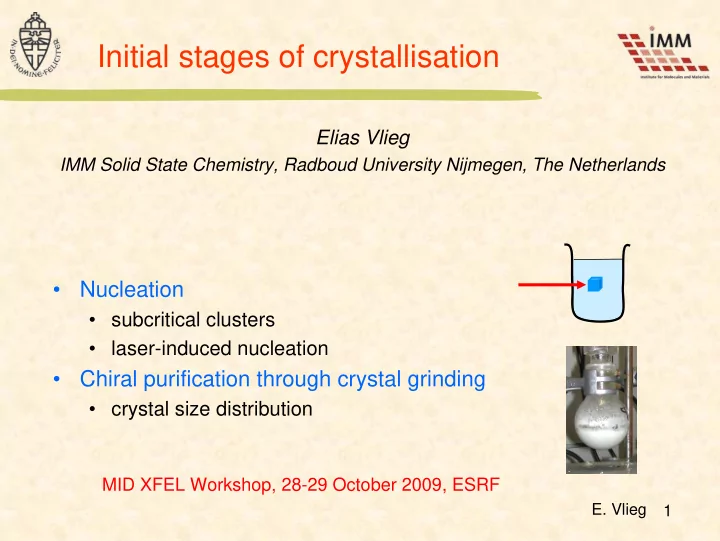

Initial stages of crystallisation Elias Vlieg IMM Solid State Chemistry, Radboud University Nijmegen, The Netherlands • Nucleation • subcritical clusters • laser-induced nucleation • Chiral purification through crystal grinding • crystal size distribution MID XFEL Workshop, 28-29 October 2009, ESRF E. Vlieg 1
Classical nucleation theory • Crystal nucleation not well understood • too fast • too few • too small • Important • dictates crystalline form (polymorph) • pharmaceutical industry! • Ostwald’s rule of stages • first least stable crystal is formed, later more stable • happens during nucleation E. Vlieg 2
Nucleation • dominated by surface/size effects γ • nucleation barrier • classical nucleation theory • assume spherical nucleus, radius r driving force: Δμ • surface free energy: γ • • volume per growth unit: V 0 20 nucleation barrier 15 and critical radius • Free energy: 10 π 3 3 r 5 = − Δ μ + π γ energy 2 4 G ( r ) 4 r 0 0 2 4 6 8 10 V -5 o -10 -15 bulk crystal: surface energy: -20 radius gain loss E. Vlieg 3
Effect of supersaturation σ ⎛ ⎞ • Probability of nucleation c ⎜ ⎟ Δ μ = = σ kT ln kT ⎜ ⎟ depends strongly on c ⎝ ⎠ eq supersaturation • Solution contains 20 transient clusters below the critical size 15 10 5 σ = 1 % G (eV) σ = 10 % 0 0 2 4 6 8 10 σ = 100 % -5 -10 -15 -20 r (nm) E. Vlieg 4
Observing nuclei Two options 1. Watch actual nucleation event • rare 2. Watch transient precritical clusters • lots E. Vlieg 5
Precritical clusters • sample cell of 5 mm • KCl critical cluster at σ = 5%, n * = 220 • 1.E+20 # observable clusters 1.E+15 -10% 1.E+10 0% 5% 1.E+05 1.E+00 1 10 100 1000 n E. Vlieg 6
Observable intensity peak ≈ ψ 2 I ( nF r ) e flux 10 12 photons/pulse • • after single pulse, cluster destroyed (?) • n ~ 220 • F ~ 35 # scattered photons in single pulse 10 x 10 µm 2 beam: • ~5 1 x 1 µm 2 beam: • ~500 0.1 x 0.1 µm 2 beam: • ~50,000 OK? E. Vlieg 7
Beyond critical clusters • Need larger cluster = growing nucleus • How to find nucleus at the right time and the right place? • random • like winning the lottery • rapidly nucleating system will increase chances • many experiments are possible at rep-rate of XFEL • select only the successful ones • high-energy physics style E. Vlieg 8
Laser-induced nucleation • Idea: use laser to induce nucleation • has been observed on e.g. KCl in single pulse • A.J. Alexander and P.J. Camp, Cryst. Growth & Design 9 (2009) 958. • ‘instantaneous’ (single pulse of 7 ns 1064 nm laser) • Should produce growing nucleus at right time and place • In situ: at least 12.4 keV laser XFEL supersaturated time delay up to solution seconds E. Vlieg 9
Intensity from nucleus Observe growing cluster after small time delay, 1 µm 2 beam • 3 x 10 7 photons/pulse • radius 10 nm; n = 58,000 5 x 10 10 photons/pulse • radius 50 nm; n = 7.3 x 10 6 • Many experiments needed • orientation of nucleus is random • Determine • shape • crystallinity • Bragg scattering: crystalline part • forward scattering: high-density part • polymorph E. Vlieg 10
Non-classical nucleation normal order alternative density • Two step mechanism • first density change • next crystalline order • Again: Bragg + forward scattering E. Vlieg 11
Experimental geometry top view Bragg area detectors laser forward XFEL sample beamstop • single shot • system needs time to recover or move to fresh position E. Vlieg 12
Chirality • Many molecules have handedness • left/right • +/- • D/L • R/S (absolute configuration) • Non-superimposable mirror images • Enantiomers D-tartaric acid • Chemical synthesis • usually racemic (50:50) mixture • Natural amino acids L-tartaric acid mirror • (almost all) left-handed • why? E. Vlieg 13
Enantiomers • In achiral environment • same physical properties (melting point, etc.) • In chiral environment (human body) • very different properties • often important to select one enantiomer (drugs, thalidomide ) m limonene E. Vlieg 14
Chiral purification through crystal grinding Model system • N -(2-methylbenzylidene)-phenylglycine amide • DBU as racemizing catalyst E. Vlieg 15 Wim Noorduin et al., J. Am. Chem. Soc. 130 (2008) 1158
Mechanism? Attrition-enhanced Ostwald ripening • Ostwald ripening • crystals get bigger • Attrition NaClO 3 , • crystal get smaller Wim Noorduin et al. Crystal Growth & Des. 8 (2008) 1675 Measure evolution nr. of crystals in crystal size distribution ripening grinding size E. Vlieg 16
Crystal size distribution • tens of thousands of crystals • size from nm (dissolving) to ~10 µm • Smallest crystals are thought to play crucial role • direct incorporation • ideally: distinguish between left and right E. Vlieg 17
XFEL experiment XFEL detector • Extract size and shape from coherent images along powder ring • large crystals: easy • small crystals (important!): difficult • Accumulate statistics by several separated shots • give system some recovery time • Watch evolution E. Vlieg 18 • hours time scale
Conclusion • XFEL should make nucleation visible • For in situ experiments, harder X-rays useful E. Vlieg 19
Recommend
More recommend